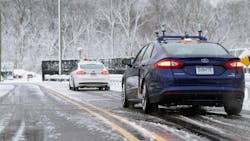Self-Driving Technology's Latest Frontier: Snow
Snow finally hit Detroit this weekend, and just in time for Ford to test autonomous vehicles in wintry climes for the North American International Auto Show.
Ford is saying that its testing in snowy conditions--which it’s doing in Michigan at sites including the University of Michigan’s Mcity--is an industry first. Although Google cars have probably traveled every sunny back road in Mountainview, Calif., and city street in Austin, Texas, you don’t see them tooling around in bad-weather states--yet.
“It’s one thing for a car to drive itself in perfect weather,” Jim McBride, Ford technical leader for autonomous vehicles, said in a statement. “It’s quite another to do so when the car’s sensors can’t see the road because it’s covered in snow. Weather isn’t perfect, and that’s why we’re testing autonomous vehicles in wintry conditions – for the roughly 70% of U.S. residents who live in snowy regions.”
Ford is testing a fleet of fully autonomous Fusion hybrids in locations including Mcity, a 32-acre simulated real-world urban environment at the University of Michigan.
In ideal weather, LiDAR is the most efficient means of gathering important information and metadata – underlying information about the data itself – from the surrounding environment, sensing nearby objects and using cues to determine the best driving path. But on snow-covered roads or in high-density traffic, LiDAR and other sensors such as cameras can’t see the road. This is also the case when the sensor lens is covered by snow, grime or debris.
Ford and University of Michigan technologists have been collaborating on a solution that would allow an autonomous vehicle to see on a snow-covered road.
To navigate snowy roads, the vehicles are equipped with high-resolution 3D maps – complete with information about the road and what’s above it, including road markings, signs, geography, landmarks and topography.
“Maps developed by other companies don’t always work in snow-covered landscapes,” said Ryan Eustice, associate professor at University of Michigan college of engineering, in a statement. “The maps we created with Ford contain useful information about the 3D environment around the car, allowing the vehicle to localize even with a blanket of snow covering the ground.”
An autonomous vehicle creates the maps while driving the test environment in favorable weather, with technologies automatically annotating features like traffic signs, trees and buildings. When the vehicle can’t see the ground, it detects above-ground landmarks to pinpoint itself on the map, and then subsequently uses the map to drive successfully in inclement conditions.
“The vehicle’s normal safety systems, like electronic stability control and traction control, which often are used on slippery winter roads, work in unison with the autonomous driving software,” said McBride. “We eventually want our autonomous vehicles to detect deteriorating conditions, decide whether it’s safe to keep driving, and if so, for how long.”
Earlier this month, Ford announced it was tripling its fully autonomous development fleet to 30 vehicles being tested on roads and test tracks in California, Arizona and Michigan.
About the Author
IW Staff
Find contact information for the IndustryWeek staff: Contact IndustryWeek
